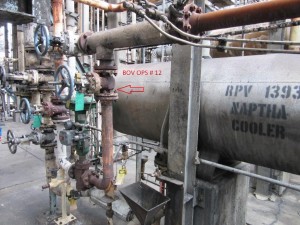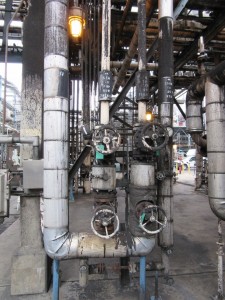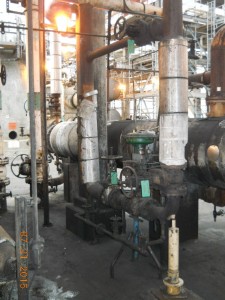Coking is a refinery unit operation that upgrades material called bottoms from the atmospheric or vacuum distillation column into higher-value products and, as the name implies, produces petroleum coke, a coal-like material.

Two types of coking processes exist—delayed coking and fluid coking. Both are physical processes that occur at pressures slightly higher than atmospheric and at temperatures greater than 900F/485C that thermally crack the feedstock into products such as naphtha and distillate, leaving behind petroleum coke.

With delayed coking, two or more large reactors, called coke drums, are used to hold, or delay, the heated feedstock while the cracking takes place. While the lighter products are pumped back into the fractionator through the overhead vapor lines, coke is deposited in the coke drum as a solid. This solid coke builds up in the coke drum and is removed by hydraulically cutting the coke using water. In order to facilitate the removal of the coke, the hot feed is diverted from one coke drum to another, alternating the drums between coke removal and the cracking part of the process. With fluid coking, the feed is charged to a heated reactor, the cracking takes place and the formed coke is transferred to a heater as a fluidized solid where some of it is burned to provide the heat necessary for the cracking process. The remaining coke is collected to be sold. 
Operations in any refinery’s delayed coking unit are extremely severe, perhaps the harshest of any refinery operation due to the batch nature of the process, daily swings from very high temperatures to ambient, high vibration on the deck as well as the significant potential for coke buildup in the equipment. Over time, depending on steam purge system reliability and effectiveness, coke may build up in the valves and valve operating torques may increase accordingly. Torque increases put additional stress on these ball valves and on the electric actuator that operate them. Designing a robust valve and providing an ample safety factor when selecting these actuators is key in ensuring uninterrupted operation between scheduled turnarounds.

The high pressure water lines used to drill out and cut the coke from the drum internals
create pressure in excess of 4000psi. The steam and quench water and occasional “hotspots” in the drum are susceptible to rapid expansion and temperature fluctuations of condensate and water often producing water hammer and blowouts. Further, due to corrosion in traces of sulfur combined with the unit’s wash down water, significant amount of abrasive airborne dust is created, covering all surfaces within the drum and its immediate surroundings. The coke dust not only creates challenges for corrosion but builds up in crevices, impeding functionality, with harsh conditions that are hot and potentially dangerous. Such areas require higher exotic alloys to deal with.
Each drum in the coking process require 10 to 12 valves for recirculation, switching, quenching, stripping, washing, reheating steam, etc. Valve sizes and pressure class have been increasing significantly over the last few years as end users look to increase both throughput and yields. Note: These severe and harsh conditions of the coker operation often have a detrimental effect on these valves and the actuators operating them. Further making it more critical is the fact that the valves must work on a schedule of sequential strokes to divert in a precisely timed event.
Valves’ (operating) sequence is controlled through a distributed control system or standalone, dedicated progammable logic controller (older units still sometimes rely on relay driven panels) and an actuator which should be reliable. The valve and actuator unit must have safety interlocks restricting their opening and closing through limit switches that provide positive position feedback to maintain safe process control. Despite the fact that most safety systems have an interlock bypass mode in order to complete a sequence, an inoperable valve actuator must be reinstated quickly so that the system can continue functioning safely. If the actuator fails, the valve should be capable to operate manually (normally such operation is strenuous and time consuming, hence not a preferred option) although several units now rely on pneumatic wrenches to complete the cycle.
With such applications, while valves can be switched out for maintenance, the actuators (while in operation) need to be reliable. In addition, mean time between failure can be a costly affair on such demanding application.
Valve issues are most often related to coke buildup which may render the valve difficult or impossible to operate. Water hammer and vibrations sometimes results in unwanted stroking, broken internals, dislodged components of actuation, disconnection of motors, penetration of coke dust in critical areas, clogging, eroding, etc.
Installation of a robust valve and actuator solution provides extended service life and results in critical severe service valve selection and installation in exceptional and demanding services, such as coking.
Summary:
The importance of coker valves cannot be understated. This is a batch process and the coker can become a potential bottleneck in a continuous refining operation. If the critical coke drum filling, switching and decoking schedule gets interrupted, it could impact the entire refinery production. It could also impact the entire refinery throughput, costing a user millions of dollars per day in lost production. The valve actuator, seemingly a very small item in the total process, has a significant importance and a great impact on the delayed coking operation. Premature failure can lead to extra costs for operator overtime, additional manpower for manual valve operation, replacement costs and potential refinery downtime, not to mention the safety aspects of manual operation. A robust solution is a metal-seated ball valve with hard chrome coating or tougher material overlay with actuation of field-proven ductile iron-housed, powder-coated, compact size, unique internal electric circuitry configuration and modified hard-wire operation which could provide considerable cost savings to potential shutdowns of this critical operation unit in a refinery.
About the Author
 Mr. Gobind Khiani M.Eng., P. Eng. has served in engineering and project management roles for both Operating and Engineering, Procurement and Construction (EPC) companies. He has a bachelor’s degree in Piping Design & Engineering from the University of Pune, India and Master’s of Engineering from the University of Calgary, Alberta. Currently, he is Global Valve SME with Fluor Canada Ltd, at Piping Engineering Group. He is the Chairman of Calgary Branch Executive Committee at APEGA and Valve Users Group. Gobind has experience in Piping/Pipelines, Valves, Surge/Control Valve Selection and Sizing, Modularization in Valves, Safety Integrity of Piping Systems, Refining and Severe Service Valves, fugitive Emissions, and material selection. Gobind is an active member of API, ISO, and CSA.
Mr. Gobind Khiani M.Eng., P. Eng. has served in engineering and project management roles for both Operating and Engineering, Procurement and Construction (EPC) companies. He has a bachelor’s degree in Piping Design & Engineering from the University of Pune, India and Master’s of Engineering from the University of Calgary, Alberta. Currently, he is Global Valve SME with Fluor Canada Ltd, at Piping Engineering Group. He is the Chairman of Calgary Branch Executive Committee at APEGA and Valve Users Group. Gobind has experience in Piping/Pipelines, Valves, Surge/Control Valve Selection and Sizing, Modularization in Valves, Safety Integrity of Piping Systems, Refining and Severe Service Valves, fugitive Emissions, and material selection. Gobind is an active member of API, ISO, and CSA.








Leave a Reply
You must be logged in to post a comment.